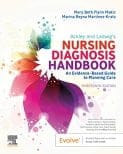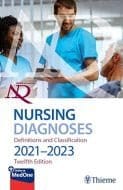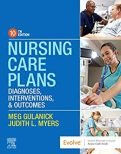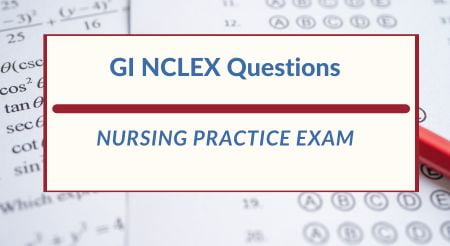GI NCLEX Questions Test Bank
Test your knowledge of gastrointestinal NCLEX Questions. This is set #3. It contains GI NCLEX Practice questions with answers and rationales.
For More GI questions, please see our Gastrointestinal NCLEX Practice Test Page.
Gastrointestinal Nursing Diagnosis and Care Plans
Results
#1. A client with burns is being transferred to the operating room for a surgical procedure. Before the procedure, the nurse should prioritize which action?
Administering preoperative antibiotics is a priority to prevent infection in clients with burns undergoing surgery.
#2. A client with burns is receiving fluid resuscitation. The nurse notes the client's urine output has increased to 200 mL/hr. What action should the nurse take?
Notifying the healthcare provider is necessary when a client’s urine output exceeds 100 mL/hr in a client receiving fluid resuscitation, as it may indicate overhydration.
#3. A client with burns is experiencing severe pain despite analgesic administration. Which intervention should the nurse implement to enhance pain relief?
Rotating between different analgesic medications helps prevent opioid tolerance and enhances pain relief in clients with burns.
#4. A client with burns is prescribed hydrotherapy. What is the primary purpose of this treatment?
Hydrotherapy is used primarily to clean the burn wound and promote removal of debris and dead tissue.
#5. The nurse is assessing a client with partial-thickness burns. Which finding requires immediate intervention?
Pale and cool extremities suggest impaired circulation and require immediate intervention to prevent tissue ischemia.
#6. A client with burns is prescribed a muscle relaxant for pain management. Which medication should the nurse anticipate administering?
Baclofen is a muscle relaxant commonly used for pain management in clients with burns.
#7. The nurse is caring for a client with burns and recognizes signs of inadequate fluid resuscitation. Which finding supports this conclusion?
Decreased urine output is a sign of inadequate fluid resuscitation and suggests ongoing hypovolemia.
#8. A client with burns is prescribed a tetanus toxoid vaccine. What is the primary purpose of this immunization?
The primary purpose of a tetanus toxoid vaccine is to provide protection against tetanus infection, which can occur from contaminated wounds.
#9. A client with burns is at risk for impaired skin integrity. Which intervention should the nurse implement to minimize the risk of pressure ulcers?
Using a pressure-relieving mattress helps minimize the risk of pressure ulcers in clients with burns by reducing pressure on vulnerable areas.
#10. A client with burns is prescribed opioid analgesics for pain management. What should the nurse include in the client's discharge teaching?
“You may experience constipation as a side effect of the medication” should be included in the client’s discharge teaching to promote awareness and address potential side effects.
#11. A client with burns is experiencing anxiety and restlessness. Which intervention should the nurse implement to promote relaxation?
Encouraging the client to practice deep breathing exercises helps promote relaxation and reduce anxiety in clients with burns.
#12. A client with burns is prescribed a topical antimicrobial cream. What is the primary purpose of this medication?
A topical antimicrobial cream is used primarily to prevent infection in burn wounds due to its antimicrobial properties.
#13. A client with burns is receiving enteral nutrition. Which action should the nurse take to prevent aspiration during feedings?
Elevating the head of the bed at a 30-degree angle during feedings helps prevent aspiration in clients with burns.
#14. The nurse is caring for a client with full-thickness burns. Which finding requires immediate intervention?
A blood pressure of 90/60 mmHg suggests hypovolemia and requires immediate intervention to prevent hypovolemic shock.
#15. A client with burns is experiencing impaired mobility. Which intervention should the nurse prioritize to prevent contractures?
Assisting with passive range-of-motion exercises is crucial to prevent contractures and maintain joint mobility in clients with burns.
#16. A client with burns is prescribed a topical corticosteroid cream. What is the primary purpose of this medication?
A topical corticosteroid cream is used to reduce inflammation and itching associated with burns, providing symptomatic relief.
#17. A client with burns is experiencing pruritus (itching) at the burn site. Which intervention should the nurse implement?
Administering an antihistamine medication is appropriate for relieving pruritus in clients with burns.
#18. A client with burns is prescribed opioid analgesics for pain management. Which intervention should the nurse implement to minimize the risk of respiratory depression?
Monitoring oxygen saturation levels regularly helps detect early signs of respiratory depression in clients receiving opioids for pain management.
#19. A client with burns is prescribed a muscle relaxant for pain management. Which medication should the nurse anticipate administering?
Baclofen is a muscle relaxant commonly used for pain management in clients with burns.
#20. The nurse is caring for a client with burns and recognizes signs of inadequate fluid resuscitation. Which finding supports this conclusion?
Decreased urine output is a sign of inadequate fluid resuscitation and suggests ongoing hypovolemia.
#21. A client with burns is experiencing severe pain despite analgesic administration. Which intervention should the nurse implement to enhance pain relief?
Rotating between different analgesic medications helps prevent opioid tolerance and enhances pain relief in clients with burns.
#22. A client with burns is prescribed hydrotherapy. What is the primary purpose of this treatment?
Hydrotherapy is used primarily to clean the burn wound and promote removal of debris and dead tissue.
#23. The nurse is assessing a client with partial-thickness burns. Which finding requires immediate intervention?
Pale and cool extremities suggest impaired circulation and require immediate intervention to prevent tissue ischemia.
#24. A client with burns is experiencing anxiety and restlessness. Which intervention should the nurse implement to promote relaxation?
Encouraging the client to practice deep breathing exercises helps promote relaxation and reduce anxiety in clients with burns.
#25. A client with burns is prescribed a topical antimicrobial cream. What is the primary purpose of this medication?
A topical antimicrobial cream is used primarily to prevent infection in burn wounds due to its antimicrobial properties.

Best Nursing Books and Resources
These are the nursing books and resources that we recommend.
NurseStudy.net is a participant in the Amazon Services LLC Associates Program. Included below are affiliate links from Amazon at no additional cost from you. We may earn a small commission from your purchase. Please see our Privacy Policy

The Nursing Diagnosis Handbook E-Book: An Evidence-Based Guide to Planning Care
This is an excellent reference for nurses and nursing students. While it is a great resource for writing nursing care plans and nursing diagnoses, it also helps guide the nurse to match the nursing diagnosis to the patient assessment and diagnosis.
This handbook has been updated with NANDA-I approved Nursing Diagnoses that incorporates NOC and NIC taxonomies and evidenced based nursing interventions and much more.

NANDA International Nursing Diagnoses: Definitions & Classification, 2021-2023
All introductory chapters in this updated version of a ground-breaking text have been completely rewritten to give nurses the knowledge they require to appreciate assessment, its relationship to diagnosis and clinical reasoning, and the goal and use of taxonomic organization at the bedside.

Nursing Care Plans: Nursing Diagnosis and Intervention
It contains more than 200 care plans that adhere to the newest evidence-based recommendations.
Additionally, it distinguishes between nursing and collaborative approaches and highlights QSEN competencies.


